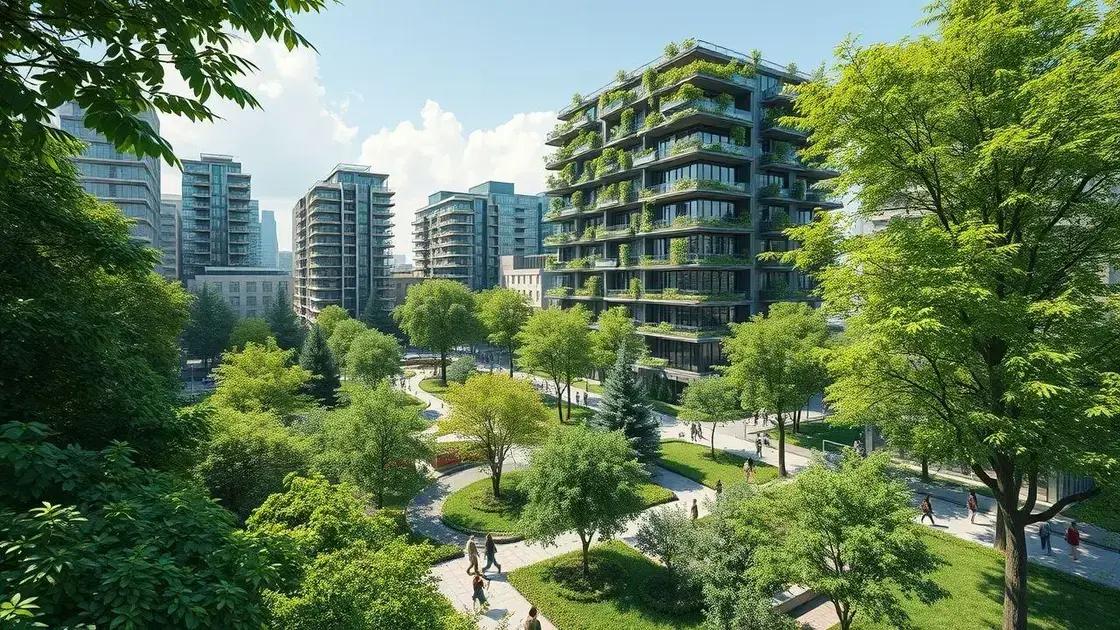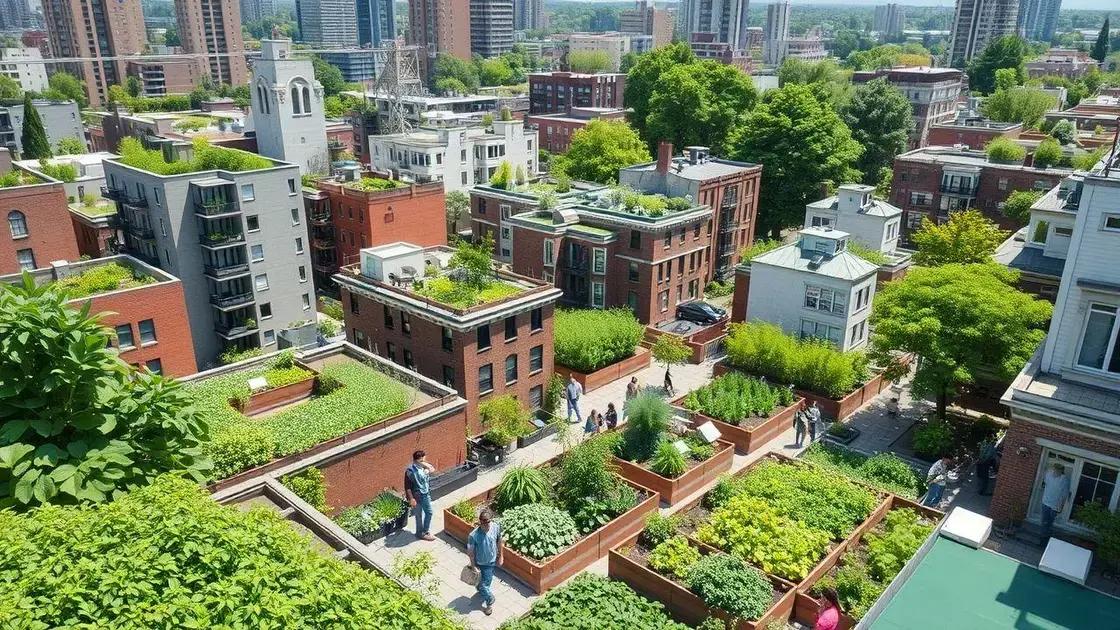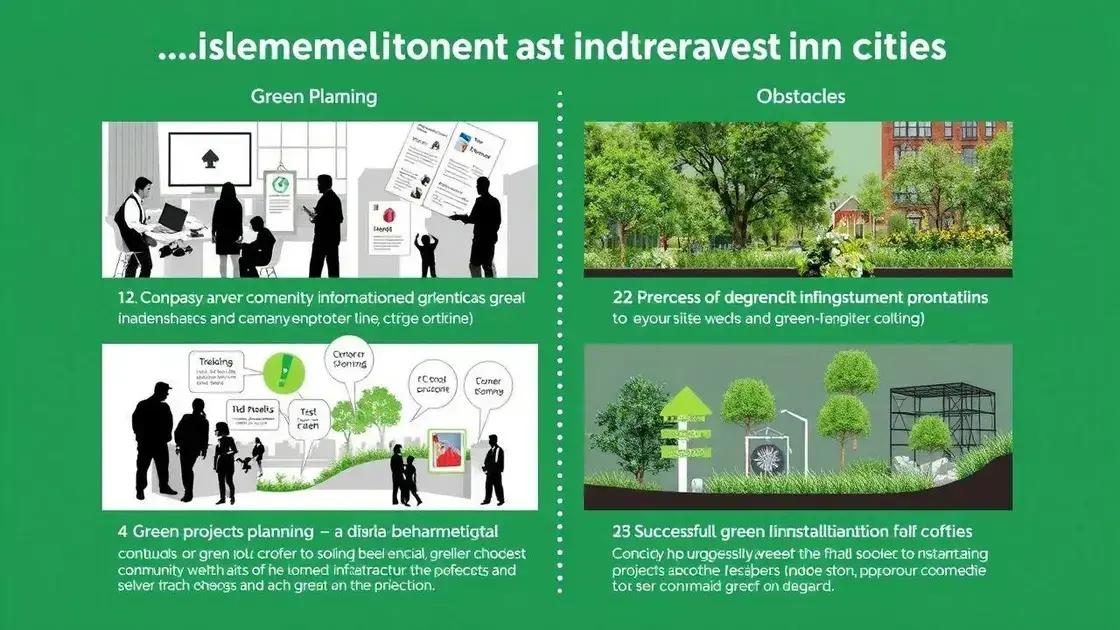Green infrastructure headlines trends shaping our cities

Green infrastructure offers numerous benefits, including improved air quality, increased property values, and enhanced community engagement, while addressing urban challenges such as stormwater management and heat reduction.
Green infrastructure headlines trends are not just buzzwords; they represent a shift towards more sustainable urban living. Have you ever considered how our cities can become greener and more resilient?
Understanding green infrastructure
Understanding green infrastructure is crucial for grasping how we can enhance our urban landscapes. It represents a transformative approach that integrates nature into our cities. Instead of just focusing on concrete and asphalt, we’re learning to incorporate parks, green roofs, and urban forests into our planning.
The Core Concepts
At its heart, green infrastructure aims to use natural processes to manage stormwater, improve air quality, and boost biodiversity within urban settings. These practices not only contribute to healthier ecosystems but also enhance the quality of life for residents.
Key Features of Green Infrastructure
- Permeable surfaces: These allow water to pass through, reducing runoff and supporting groundwater recharge.
- Green roofs: They provide insulation, reduce urban heat, and support vegetation.
- Urban forests: Trees in cities improve air quality and provide shade.
By understanding these core components, we can see how they work together. From the benefits of green roofs to the importance of urban trees, the adoption of green infrastructure offers multiple opportunities to reshape our environment. Each element plays a part in creating a cohesive network that supports urban ecosystems.
Moreover, engaging communities in these initiatives fosters a sense of ownership and responsibility toward our green spaces. As we understand more about green infrastructure, we empower ourselves to advocate for more sustainable practices in our neighborhoods.
Current trends in green infrastructure

Understanding the current trends in green infrastructure helps us navigate the future of urban development. As more cities adopt sustainable practices, exciting innovations are emerging, reshaping our environments.
Emerging Technologies
One of the biggest trends is the integration of technology into green infrastructure. Innovations such as smart water management systems and advanced green technologies are making cities more efficient while minimizing environmental impacts.
Focus on Community Engagement
Community involvement is also key. Cities are recognizing the importance of engaging local residents in the planning and maintenance of green spaces. When people participate, they develop a connection to their environment.
- Workshops: These help educate community members about sustainable practices.
- Volunteer programs: Initiatives allow residents to contribute to local green projects.
- Feedback opportunities: Gathering community input ensures that developments meet local needs.
In addition, many cities are undergoing transformations to include more green roofs and living walls. These features not only beautify urban areas but also provide insulation and reduce energy costs. More businesses and buildings are prioritizing these elements when planning new constructions.
Another notable trend is the rise of urban agriculture. More people are planting gardens on rooftops and community plots. This practice not only supplies fresh food but also strengthens community ties, enhances biodiversity, and fights food deserts in urban areas.
As we observe these trends, it becomes clear that green infrastructure is here to stay. From smart technologies to community-driven projects, these changes indicate a shift towards more resilient and sustainable cities.
Benefits of implementing green infrastructure
The benefits of implementing green infrastructure extend far beyond aesthetics. Embracing these practices can lead to significant improvements in urban environments, making them healthier and more resilient.
Environmental Advantages
First and foremost, green infrastructure helps manage stormwater effectively. This means less flooding and reduced strain on sewage systems. By allowing water to absorb through vegetation and permeable surfaces, cities can drastically decrease runoff pollution.
- Improved air quality: Green plants filter pollutants and produce oxygen, enhancing urban air.
- Biodiversity support: Urban green spaces attract various species, contributing to ecological balance.
- Climate regulation: Trees and vegetation lower urban temperatures, combating the heat island effect.
Moreover, these infrastructures create vital habitats for wildlife. As more natural areas are integrated into urban planning, we encourage the flourishing of plants and animals within city limits.
Economic Benefits
Shifting to green infrastructure not only helps our environment but also fosters local economies. More green spaces can increase property values and attract more visitors, leading to higher business revenue.
Additionally, investing in green infrastructure can save cities money in the long run. With lower maintenance costs for stormwater systems and reduced healthcare costs from improved air quality, these upfront investments yield substantial savings.
Furthermore, enhanced public health outcomes are linked to green infrastructure. Access to well-maintained parks and green spaces encourages physical activity, leading to healthier lifestyles for residents. These spaces provide opportunities for exercise, relaxation, and community gathering.
As we can see, the multiple benefits of green infrastructure are compelling reasons for cities to adopt these approaches. From environmental sustainability to economic vitality, these practices build a foundation for resilient urban living.
Challenges and solutions for green infrastructure

Implementing green infrastructure comes with its own set of challenges. Understanding these obstacles is crucial to developing effective solutions. From financial limitations to public perception, various factors can hinder the adoption of green initiatives.
Financial Constraints
One of the most significant challenges is the initial cost. Many cities face budget restrictions that make it tough to invest in eco-friendly projects. These upfront expenses can discourage local governments from pursuing green options, even when the long-term benefits are clear.
- Funding sources: Cities should explore grants, public-private partnerships, or community fundraising efforts to bolster budgets for green initiatives.
- Cost analysis: Conducting comprehensive studies can demonstrate the long-term savings associated with green infrastructure.
- Investment in education: Teaching city planners about the benefits of green infrastructure can lead to increased support.
Moreover, successfully implementing these solutions often means navigating complex regulations and approval processes. It can take significant time and effort to navigate city policies, potentially slowing down or derailing projects.
Public Perception and Involvement
Public perception also plays a crucial role. Many residents might not understand the benefits of green infrastructure or fear change within their neighborhoods. Engaging the community is essential for gaining support and ensuring participation.
Conducting surveys or hosting workshops can provide residents a platform to voice concerns and learn about the advantages of green projects. Additionally, showcasing successful examples from other cities can help inspire confidence and enthusiasm.
As we work towards overcoming these challenges, continuous education and community engagement remain key. Green infrastructure has the potential to transform urban spaces, creating healthier environments for all.
FAQ – Frequently Asked Questions about Green Infrastructure
What are the main benefits of green infrastructure?
Green infrastructure improves air quality, reduces urban heat, and creates healthier urban spaces.
How does green infrastructure affect property values?
Implementing green infrastructure can increase property values by enhancing the appeal of neighborhoods.
What role does community engagement play in green infrastructure projects?
Community engagement ensures that residents are involved in the planning and care of green spaces, fostering support.
What challenges do cities face when implementing green infrastructure?
Cities often encounter financial constraints, regulatory hurdles, and sometimes skepticism from the public.





